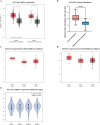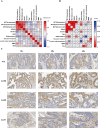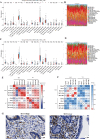Exploring the role of monocarboxylate transporter 4 in diverse KRAS mutation subtypes of colorectal Cancer
- PMID: 40603399
- PMCID: PMC12223049
- DOI: 10.1038/s41598-025-06254-9
Exploring the role of monocarboxylate transporter 4 in diverse KRAS mutation subtypes of colorectal Cancer
Abstract
This study explored the therapeutic potential of monocarboxylate transporter 4 (MCT4/SLC16A3) in KRAS-mutant colorectal cancer (CRC). By integrating immunohistochemistry with UCSC Xena database analysis, we identified a distinct MCT4 expression pattern in KRAS-mutant CRC. Cytoplasmic MCT4 expression was positively correlated with KRAS mutation status and mismatch repair (MMR) proficiency, but negatively associated with sex and tumor differentiation. Plasma membranous MCT4 expression was also positively correlated with KRAS mutations and negatively with differentiation grade. Notably, tumors harboring KRAS codon 13 mutations, particularly G13D, showed higher MCT4 expression than those with codon 12 mutations, such as G12D. Kaplan-Meier survival analysis revealed a significant association between high SLC16A3 expression and poor prognosis. Gene Ontology (GO) and Kyoto Encyclopedia of Genes and Genomes (KEGG) pathway analyses indicated that MCT4 is mainly involved in immune regulation and metabolism-related pathways. Furthermore, CIBERSORT analysis combined with immunohistochemistry confirmed a relationship between KRAS mutations and immune cell infiltration. This is the first study to systematically characterize MCT4 expression across different KRAS-mutant CRC subtypes. Our findings suggest that MCT4 may modulate the tumor immune microenvironment in KRAS-mutant CRC and could serve as a potential target for precision therapy.
Keywords: Colorectal cancer; Immunohistochemistry; KRAS; Monocarboxylate transporter 4(MCT4); SLC16A3.
© 2025. The Author(s).
Conflict of interest statement
Declarations. Competing interests: The authors declare no competing interests.
Figures





Similar articles
-
Monocarboxylate transporter 4 predicts poor prognosis in hepatocellular carcinoma and is associated with cell proliferation and migration.J Cancer Res Clin Oncol. 2015 Jul;141(7):1151-62. doi: 10.1007/s00432-014-1888-8. Epub 2014 Dec 2. J Cancer Res Clin Oncol. 2015. PMID: 25446815 Free PMC article.
-
Differential distribution of immune checkpoints across molecular subtypes of colorectal cancer.Oncoimmunology. 2025 Dec;14(1):2546406. doi: 10.1080/2162402X.2025.2546406. Epub 2025 Aug 21. Oncoimmunology. 2025. PMID: 40838947
-
KRAS amplification in colorectal cancer: correlations with clinicopathological features and prognosis in patients and prediction of response to targeted therapy.J Transl Med. 2025 Jul 24;23(1):824. doi: 10.1186/s12967-025-06864-x. J Transl Med. 2025. PMID: 40708044 Free PMC article.
-
Prognostic value of KRAS codon 13 gene mutation for overall survival in colorectal cancer: Direct and indirect comparison meta-analysis.Medicine (Baltimore). 2017 Sep;96(35):e7882. doi: 10.1097/MD.0000000000007882. Medicine (Baltimore). 2017. PMID: 28858102 Free PMC article.
-
Epidermal growth factor receptor (EGFR) inhibitors for metastatic colorectal cancer.Cochrane Database Syst Rev. 2017 Jun 27;6(6):CD007047. doi: 10.1002/14651858.CD007047.pub2. Cochrane Database Syst Rev. 2017. PMID: 28654140 Free PMC article.
References
-
- Sung, H. et al. Global Cancer statistics 2020: GLOBOCAN estimates of incidence and mortality worldwide for 36 cancers in 185 countries. CA Cancer J. Clin.71, 209–249 (2021). - PubMed
-
- Dienstmann, R., Connor, K., Byrne, A. T. & Consortium, C. Precision therapy in RAS mutant colorectal Cancer. Gastroenterology158, 806–811 (2020). - PubMed
-
- Rui, Y., Wang, C., Zhou, Z., Zhong, X. & Yu, Y. K-Ras mutation and prognosis of colorectal cancer: A meta-analysis. Hepatogastroenterology62, 19–24 (2015). - PubMed
-
- Benson, A. B. et al. Colon cancer, version 2.2021, NCCN clinical practice guidelines in oncology. J. Natl. Compr. Canc Netw.19, 329–359 (2021). - PubMed
MeSH terms
Substances
Grants and funding
LinkOut - more resources
Full Text Sources
Medical
Miscellaneous

